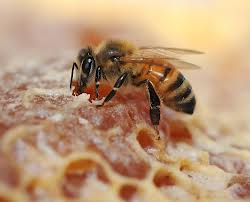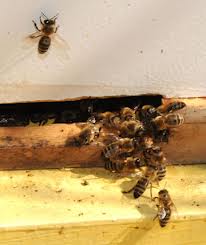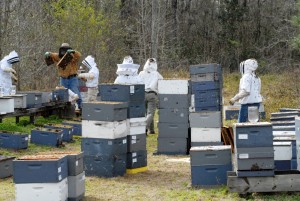
Honey bees laboriously gather their food (nectar and pollen) from flowers in bloom and store it in the hive for use when needed. When nectar sources are scarce or unavailable locally, bees are attracted by the honey stored in neighboring hives. Bees from strong colonies raid hives that are unable to defend themselves and steal the weak colonies’ honey or sugar syrup. This behavior of thievery as opposed to the customary colony collections of nectar from flowers is termed “robbing.” (From Robber Bees by Khalil Hamdan)

Generally, robbing occurs especially during a dearth, or scarcity, of nectar. Bees will never rob during a nectar flow or as long as abundant nectar is available in the field. As nectar becomes more scare, the intensity of robbing increases. Strong colonies rob the weaker ones or those that are poorly guarded. The robber bees are the forager, or scout, bees. They are after honey, and do not steal pollen or damage brood. (From Robber Bees by Khalil Hamdan)
From a bee’s point of view, robbing is just a type of foraging behavior. A potential robber is a scout bee seeking resources for her colony. She lands at the entrance of a weak hive and fights with a guard bee; these battles are fierce and one of the bees may die. If the robber wins entry, she seeks out cells of honey or syrup, fills her crop with it, and returns to her colony to deposit her spoils and recruit more robbers. A robber bee will try to enter the colony any way possible, including under the lid, around the area where supers join, at other joints in the colony, or any cracks and holes in old wooden-ware.
A weak colony does not have enough bees to defend against large numbers of robbers from a more populous colony. Robbing bees become accustomed to a source of syrup/nectar/honey and may rob a weak colony for several days in a row. This relentless attack dooms the colony unless the beekeeper intervenes.
As with many other problems in beekeeping, robbing can be reduced by maintaining queen-right colonies of uniform strength. Weak colonies set among stronger neighbors are at great risk. Once stronger hives begin robbing weaker ones, an escalating feeding frenzy can engulf the whole apiary, with bees from many hives robbing each other.
If robbing begins in an apiary, it is nearly impossible to stop the first day. However, the following management practices should help:
- Eliminate the stimulus. Clean up or cover exposed honey or syrup and tape shut cracks between supers.
- Reduce entrances of vulnerable colonies with entrance reducers or grass.
Note: If you take these steps, robbing usually will not resume the next morning.
If robbing is a chronic problem in your apiary:
- move weaker colonies to another location.
- Fix the problem that made the hives weak in the first place; requeen, feed, or equalize as needed.

If you must work hives during robbing conditions, take precautions to protect colonies.
- Work hives carefully but quickly.
- As you remove supers and set them aside, cover them with lids to contain the honey odor.
- If you spill honey or syrup on the ground, cover it up with earth or leaves.
- Avoid dripping syrup on the outside hives.
- Work bees later in the day. This gives robbing bees less time to work into a frenzy.
As a final note, you should not use chemical repellents, such as carbolic acid or phenol, at the entrance of a hive to keep robbing bees away. Though the robbing bees may be repelled by the odor, bees living in the hive may also be repelled as well.
Sources of Further information:
How to handle robbing in your beehive
Honey Bees and Beekeeping – A Year in the life of an Apiary – By Keith S. Delaplane. 138 pages Published January 28th 1996 by University of Georgia, Georgia Center for Continuing Education, Cooperative Extension Service
 0
0

Comments:
May 22, 2020
Merry, I never use salt when cooking rice and prefer to add a little bit of butter instead of olive oil because I like the taste butter imparts. However, neither olive oil nor butter are necessary for cooking rice. Another great way to cook rice is by using chicken broth instead of water. The finished rice has a delicious chicken flavor that can boost the overall richness of the final product. As for short- and medium-grain vs. long-grain rice, they are not created equal. You will generally not get the same results from short- or medium-grain rice as you will from long-grain rice, especially if a recipe specifically calls for long-grain rice. Long-grain rice, when cooked, is dry and loose, whereas short- and medium-grain rice is sticky and clumps together. For fried rice, long-grain is best. Short-grain rice is great for rice pudding and sushi, whereas medium-grain rice is best used for dishes such as risotto. Samantha Kennedy, M.S. Family and Consumer Sciences Agent UF/IFAS Extension Wakulla County
May 21, 2020
This is quite helpful. Being in self isolation quite a distance from home, I inevitably needed a culinary companion. This site has been the guide I so much needed. Cooking rice is the combination of art and science. I sometimes see chefs sprinkling salt and olive oil when preparing rice, what’s your take on this? And would you get the same results if you used short or medium grain variety?
August 19, 2016
Thanks for writing about organic gardening. More and more gardeners are turning to it, but there are still more to convince. I want to correct the notion that organic gardens require lots of work, particularly weeding. I practice a form of organic gardening that uses heavy mulches to suppress weeds. Mulches also protect the soil from burning up under our hot subtropical sun, promote beneficial microbial activity, and add organic matter to the soil when they eventually break down. This results in an average of about 5 minutes a month spent weeding a 1500 square foot garden. I'm guessing it takes quite a bit longer than that to spray poisonous herbicides over the same area. I've been using this method for over 17 years with wonderful results and would never go back to bare earth gardening.
July 18, 2016
I am not familiar with nurseries in Okaloosa County, but you should try calling the extension office located at 3098 Airport Road Crestview, FL 32539 Phone: (850) 689-5850 or email the horticulture agent Larry Williams lwilliams@co.okaloosa.fl.us
July 17, 2016
Where can I find a kumquat tree in Okaloosa County?
June 29, 2016
Hi Donna. For better results, zoysiagrass require frequent fertilization. Periodic soil testing should be conducted every 2 to 3 years as the basis for applications of lime and fertilization. Your local county extension office can help with your soil testing needs. Soil test results will help determine management measures, such as to maintain the proper soil pH between the desired range of 6.0 to 6.5 and keep the nitrogen, phosphorous, and potassium levels at recommended levels. For minimum maintenance, it is recommended to apply between 2 to 3 pounds of actual nitrogen per 1,000 square feet of zoysiagrass lawn per year in north Florida. To accomplish this, apply a complete fertilizer such as 16-4-8, 13-13-13, or10-10-10 at least three times a year in April, June, and August.
June 22, 2016
So what months should zoysia be fertilized and with what type fertilizer? I put it my small backyard a couple years ago.
May 1, 2016
Two green thumbs up! Old-timers here in Pensacola say you can pinch back azaleas 'til the Fourth of July and still get a good bloom; this works well for me. (They also say you should plant your potatoes and fertilize your rose bushes on Valentine's Day and that you can pinch back your poinsettias until Labor Day. This also works well for me as far as the rose bushes and poinsettias go. I haven't tried potatoes yet, but maybe I'll try planting some on Valentine's Day, 2017.)
March 20, 2016
Very well written article, and easy to follow http://www.lectiiapicultura.ro/
June 10, 2015
We know all about plants, but not about the law. You may want to consult a lawyer or state agency that deals with these issues. Good luck!
May 31, 2015
Can the HOA's stop you from having a small garden? There is nothing in the Master Documents that address this issue in particular.
May 28, 2015
Ants are also amazing. They aerate the soil, help with decomposition and waste removal, plant seeds, and are food for many birds and other animals. I'm all for getting rid of the invasive fire ants but I'd discourage people from killing the other ants in their yards.
August 20, 2014
Thanks for the timely article. One of the things I dislike about vacations is that I have to leave my plants unattended. I think the points you raised were just perfect. As to houseplants, I would only add that there are self-watering systems one can use as well. They’re better than nothing if you’re going to be away for an extended period of time. Richard www.naturehills.com
August 1, 2014
Hello Roy, My wife and I have been raising bees for about a year. As novice beekeepers we are seeking natural methods instead of the chemical practices you mentioned in the article to ensure a healthy hive in the spring. We are open to any suggestions you may have. Thank you in advance for your help. Brett
May 24, 2014
Great article but you did not mention soil Ph. I have quite a few daylilies but their foliage is slightly yellow. I have used a good fertilizer but wonder if the Ph is not right. Thanks for any information you can provide. Carolyn
November 8, 2013
am really happy for the services you offer to, to me am a student studying apiculture in uganda, am more interested in knowing how robbing occurs within on colony. thanks to you
November 6, 2013
William, thanks for your question. This is a common issue, since many folks apply fertilizer to centipede grass late in the year to green it up. Doing this does little or nothing for greening up the lawn and can actually harm the grass by encouraging growth when it is entering its dormant period. This can also encourage late season root rots. As a general rule, I would recommend the last application of fertilizer to Centipede and St. Augustine in mid September. Absolutely no ferteilzer should be applied after September 31st. For more information, take a look at this publication on Centipedegrass from UF IFAS Extension. Hope this helps, Matt
November 5, 2013
Mr. Carter- i work with the Florida Fish and Wildlife Commission and need to know when the best time to apply fall fertilizer to St. Augustine and Centipede grass; I learned in an earlier artical about the right time to apply lawn fertilizer for the spring is after the soil has warmed up...but didn't see anything mentioned about fall/winter applications. Your response is greatly appreciated. Thank you, William Doc Dockery
Comments are closed.